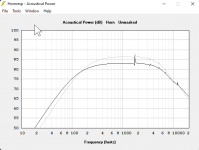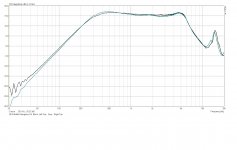Found that easily...
https://www.slaacoustics.com/produc...-wideband-drivers-pair?variant=35181642154145
https://www.slaacoustics.com/produc...-wideband-drivers-pair?variant=35181642154145
I've never heard of AP either but they have a very active Facebook page with lots of members, combined more than SS, Seas, SBA, etc.
Maybe enquire there?
Maybe enquire there?
I like the NE65 too. I don't know of any other full range with a top octave that's as nice.The NE65 is particularly nice.
Tangband is changing their 2" lineup, but they have always had a few very good ones. Worth a look at various price points.
It was reviewed in Voice Coil and modeled as 85-86dB, which seems odd (spec sheet says 82dB efficiency).
Like any other 2", it has very limited LF. The Voice Coil review shows high LF distortion at the 88dB test level.
I used mine as a wide band. Even with lots of LF gain (conical front horn about 70cm wide), I found I had to move the X-over from 500Hz to 700Hz.
On paper, this looks like a great driver.
Plugging the numbers from the spec sheet into a calculator shows slightly lower efficiency (85dB not 86dB) - which is still very good for the size, probably because it "cheats" slightl - it is slightly bigger than other nominally 2" drivers.
http://www.mh-audio.nl/Calculators/DriverReferenceEfficiency.html
The 20mm voice coil is unusual. The Bl is high and Qts is low, relative to other micro drivers, which (maybe?) contributes to the mild up-tilt to the FR plot. This tilt is, IMO a good thing. When I was hunting for an "ideal" small FR driver, I wanted conflicting things:
- good top octave (i.e. small)
- decent response / low distortion to about 500Hz
- a tilted-up FR response
...so that, after loading into a front horn, and applying subtractive EQ, it would be 90dB (or close) from about 500Hz and up.
This driver looks like it could be pretty decent for these points.
Anyone have 3rd-party measurements of the AP?
TBTL> I need to do some polar modeling and see how high I can go.
The Audible Physics driver is shockingly good.
Due to all my Unity horn projects, I consider myself a bit of an expert on small midbasses. My "go-to" driver for the past few years has been the Dayton ND64-16, which is the midbass that Floyd Toole optimized for the Dayton Epique CBT array.
The ND64-16 has very low efficiency, but it can reliably play all the way to 20khz, here's an array of horns I made with it:
https://www.diyaudio.com/community/...-with-waveguide-and-cbt-shading.266417/page-4
I was a bit suspicious that the Audible Physics driver really has an efficiency of 87dB, since it's so small, but I plugged the specs into Hornresp and it checks out. The attached sim shows the response of the Dayton ND64-16 versus the AP.
In the car audio world, people spend close to $400 a pair for their midbasses:
https://www.slaacoustics.com/produc...-wideband-drivers-pair?variant=35181642154145
Which makes me wonder if the Newark driver is a buyout.
Attachments
Not easy to see on the spec sheet but the linear xmax is quoted at 1.0mm peak to peak so only 0.5mm, even 500Hz might be a struggleThe Audible Physics driver is shockingly good.
I think you mean Don Keele 😉ND64-16, which is the midbass that Floyd Toole optimized for the Dayton Epique CBT array.
Here´s a few fullrangers that have been around a while and would be (mostly) lower endish:
http://www.spectrumaudio.de/
Click "Produkte", then "Breitbandlautsprecher" to get to the table/overview.
1st paragraph is 2" (50mm/ 2 Zoll)
Hallo, ich bin auf der Suche nach DIY Open Baffle Projekten, Zubehör und Bauplänen. Habe gesehen das Du aus Deutschland bist. Kannst Du mir da helfen? DankeHere´s a few fullrangers that have been around a while and would be (mostly) lower endish:
http://www.spectrumaudio.de/
Click "Produkte", then "Breitbandlautsprecher" to get to the table/overview.
1st paragraph is 2" (50mm/ 2 Zoll)
e-mail: fwt@gmx.ch

English please. Rules 🙂
Hi, I'm looking for DIY Open Baffle projects, accessories and blueprints. Have seen that you are from Germany. Can you help me with that? Thanks
e-mail: fwt@gmx.ch
The SPL per watt on Aurasound whisper is lower than you desire, so maybe use two of them. Stacked vertically, two would give you the constrained vertical dispersion you want.
They are very low distortion and have a very flat response if you use the correct enclosure. They run down to 500Hz just fine with good Xmax. I hot glue a 1.5" ID pipe 6 inches long or more tightly stuffed with fiberglass to the back and get excellent results. Without the pipe enclosure they have a peak in the response around 1,500 Hz. https://www.parts-express.com/Aurasound-NSW2-326-8AT-Whisper-2-Extended-Range-Driver-296-252 I attached the response I measured from two drivers mounted in a baffle. I don't know of a driver that has a flatter response than these. At listening levels I have measured the distortion, and it is down 50 dB. Linkwitz used this driver in the Pluto design. It looks like I had a low pass filter connected when I made this measurement, as the driver has extended high end response above 15 kHz. You will quickly find that 2" drivers with a higher SPL per watt achieved that sensitivity by having a near zero Xmax. So the distortion of these higher SPL drivers will be high at the low end of their frequency range.
They are very low distortion and have a very flat response if you use the correct enclosure. They run down to 500Hz just fine with good Xmax. I hot glue a 1.5" ID pipe 6 inches long or more tightly stuffed with fiberglass to the back and get excellent results. Without the pipe enclosure they have a peak in the response around 1,500 Hz. https://www.parts-express.com/Aurasound-NSW2-326-8AT-Whisper-2-Extended-Range-Driver-296-252 I attached the response I measured from two drivers mounted in a baffle. I don't know of a driver that has a flatter response than these. At listening levels I have measured the distortion, and it is down 50 dB. Linkwitz used this driver in the Pluto design. It looks like I had a low pass filter connected when I made this measurement, as the driver has extended high end response above 15 kHz. You will quickly find that 2" drivers with a higher SPL per watt achieved that sensitivity by having a near zero Xmax. So the distortion of these higher SPL drivers will be high at the low end of their frequency range.
Attachments
Last edited:
The ND64-16 specifically does not have a flat response when used individually. It was designed to have a rising response with increasing frequency specifically to help compensate for the falling response when placed into a large array. I found this description of the driver at an Audioholics article.The Audible Physics driver is shockingly good.
Due to all my Unity horn projects, I consider myself a bit of an expert on small midbasses. My "go-to" driver for the past few years has been the Dayton ND64-16, which is the midbass that Floyd Toole optimized for the Dayton Epique CBT array.
The ND64-16 has very low efficiency, but it can reliably play all the way to 20khz, here's an array of horns I made with it:
https://www.diyaudio.com/community/...-with-waveguide-and-cbt-shading.266417/page-4
I was a bit suspicious that the Audible Physics driver really has an efficiency of 87dB, since it's so small, but I plugged the specs into Hornresp and it checks out. The attached sim shows the response of the Dayton ND64-16 versus the AP.
In the car audio world, people spend close to $400 a pair for their midbasses:
https://www.slaacoustics.com/produc...-wideband-drivers-pair?variant=35181642154145
Which makes me wonder if the Newark driver is a buyout.
https://www.audioholics.com/tower-speaker-reviews/epique-cbt24
"Don Keele mentions an interesting fact about the CBT24 and ND64-16 in personal correspondence.
All curved and circular-arc line arrays (not straight line arrays) exhibit a high-frequency power roll-off due to the varying spacing between the drivers and the listener causing progressively increasing attenuation as frequency increases. The power roll off is 3 dB/octave or 10 dB/decade above a certain frequency depending on the size and configuration of the array. In the specific case of the CBT24, this roll-off commences above approximately 300 Hz. If the array is implemented with a driver that has a flat half-space frequency response the array will exhibit this inherent roll-off. In order to make the array’s frequency response flat, this roll-off must be compensated with high-frequency lift EQ or by other means. For the CBT24, a special version of Dayton’s ND65 driver (that has a flat half-space response) called the ND64-16 was designed which has a rising +3 dB/octave frequency response from roughly 300 Hz to 6 kHz. Use of this special driver compensates the CBT24’s falling response and makes the system roughly flat from 100 Hz to 8 kHz without EQ."
olsond3> My proposed design already includes using two mids, even then the Aurasound are pretty low in sensitivity and would probably limit woofer selection.
- Home
- Loudspeakers
- Multi-Way
- 2" cone driver >87db/2.83v?

